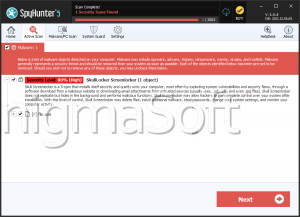Skull Ransomware
The Skull Ransomware is an encryption ransomware Trojan, used to take the victims' files hostage. The Skull Ransomware encrypts the victims' files and then demands the payment of a ransom in exchange for decrypting the victim's files. The Skull Ransomware delivers its ransom note in an HTML file named 'How_To_Decrypt_Your_Files.html,' dropped on the infected computer's desktop. The ransom note delivered simply says:
All your files have been encrypted!
If you read this file, that's mean all your files was encrypted by the Skull Ransomware.
The people responsible for providing three different Bitcoin wallet addresses for the victim to make the payment, asking for 400 USD in exchange for the decryption key and software required to recover the files encrypted by the Skull Ransomware attack. PC security researchers strongly advise computer users to avoid contacting the people responsible for the Skull Ransomware or paying the Skull Ransomware ransom. The most common way in which the Skull Ransomware is being delivered to victims is through the use of spam email attachments. The victims will receive a spam email message with an attached file that, when opened, downloads and installs the Skull Ransomware on the victim's computer. This is why learning to recognize these tactics and not falling for them is an essential part of preventing threat attacks like the Skull Ransomware.
The Skull Ransomware may Have Hijacked a Website to Display Its Ransom Note
The Skull Ransomware uses a strong encryption algorithm to make the victim's files inaccessible. The files encrypted by the Skull Ransomware are easy to recognize because the Skull Ransomware will mark them by adding a file extension made up of random characters to the affected file's name. The Skull Ransomware's ransom note is hosted on the URL 'adartmark.com/blog_howto.html,' which belongs to an online marketing firm. It is, however, very likely that this company is not linked to the people responsible for the Skull Ransomware directly but, rather, the website was hijacked by the con artists and then used to display the Skull Ransomware's ransom note. Victims of the attack are required to provide information about their computer systems when making the payment. Fortunately, the three Bitcoin wallets associated with the Skull Ransomware have remained empty, making it seem as if there are no computer users that have paid the Skull Ransomware ransom currently.
Dealing with the Skull Ransomware
Malware researchers are against computer users paying the Skull Ransomware ransom. These are some reasons for this:
- Paying these ransoms allows the con artists to continue financing these attacks and claiming new victims.
- The people responsible for the Skull Ransomware will often fail to respond, or just ignore the victim. They also may deliver a non-working solution (this is acknowledged in the Skull Ransomware's ransom note, which claims that the decryptor 'may bug out') or turn around and demand more money from the victim.
- Once a victim demonstrates a willingness to pay the ransom in one of these attacks, it is highly likely that the person will be targeted for additional ransomware and malware attacks by the people responsible for the Skull Ransomware.
Instead of paying the Skull Ransomware ransom, make sure that you have a way of recovering your data after a Skull Ransomware infection. This is because in these attacks, once the victim's files have been encrypted, they will no longer be recoverable; even if an anti-virus program is used to remove the Skull Ransomware itself, the files affected by the attack will remain encrypted and inaccessible. Because of this, having file backups is essential in protecting your data from the Skull Ransomware and similar encryption ransomware threats. Computer users are advised to backup their data on external devices. Having file backups negates the Skull Ransomware attack completely since the con artists can no longer demand ransom payments from their victims.


